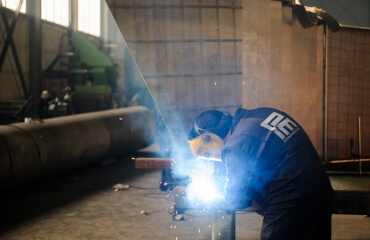Welding

MIG/MAG welding
MIG welding is arc welding with a consumable electrode in inert gas. MAG welding is arc welding with a consumable electrode in active gas. During welding, welding arc burns between the welding wire-electrode and metal parts. Protective inert or active gas ensures protection of the arc as well as of the weld pool.
MIG/MAG welding is a flexible and effective welding method. It is widely used for welding different steel, aluminium alloy articles and structures. MIG/MAG welding with powder coated welding wires is usually used for welding thicker articles of larger dimensions.
TIG welding
Tungsten inert gas welding (TIG) is a welding process that uses non-consumable tungsten electrodes. The electrode, arc and area around the molten pool are protected against air by inert gas.
TIG is a very clean method of metal welding, ensuring high quality of the joint. No slag is produced during the process, with the resulting "clean" weld, i.e. without any undesirable embedded pieces. Non-consumable electrode does not cause metal splashing. As a result, no additional post-processing of welded joints is required. TIG welding is applicable to almost all types of metals, while the welding process may be executed both manually and automatically. TIG welding is usually used for welding aluminium alloys, stainless steel, when high-quality welds are required. It is also used widely for extra high quality welding in nuclear, chemical, aviation, and food industries.
Quality guarantee
Welding works are subject to strict control under international requirements for our clients to be 100 % confident of high quality service. Our welders are certified under LST EN 287-1 standard defining the qualifications of welders performing fusion welding.
Benefits:
MIG/MAG welding
- cost-effective;
- flexible;
- efficient;
- easy to mechanize.
TIG welding
- clean welding method;
- high quality;
- no slag during welding;
- minimum joint processing required.
